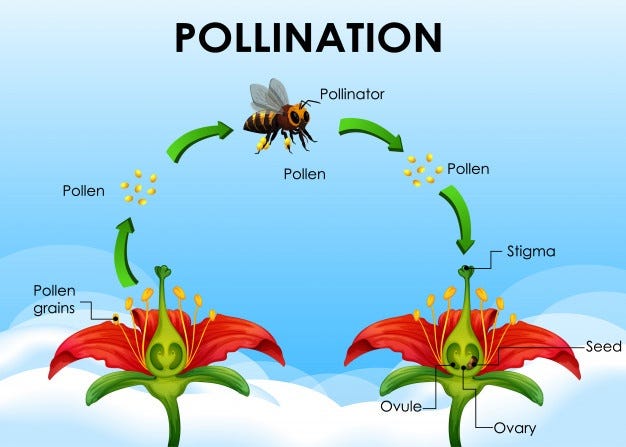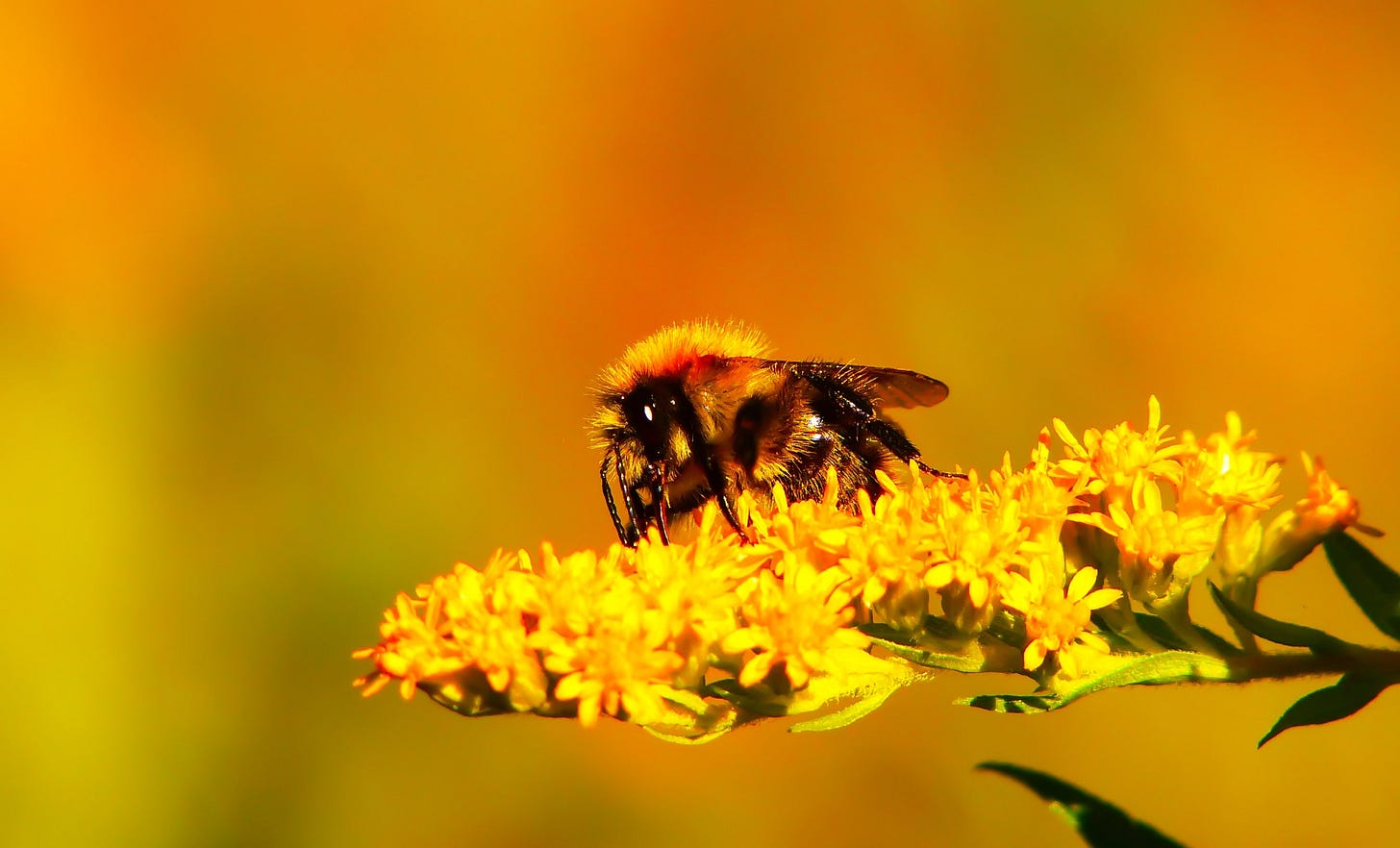What Can Pollination Teach Us About Branding?
Many of us understand the general goal of pollination - but is there a reason why bees flock to some flowers more than others?
Every so often, I read a book that really shifts my perspectives on traditional marketing. One I finished yesterday did just that.
Rory Sutherland’s Alchemy is a wonderful mix of anecdotal and theoretical concepts based on a simple idea: Human behaviour is an enigma.
The premise of Alchemy is that marketers should look beyond logic to pursue the ideas that don’t quite make sense.
Over the course of the book, Sutherland pulls from his decades-long career at Ogilvy to share frameworks for “thinking like an alchemist”, with the conclusion that market research and standard economic theory don’t fully explain human motivation.
In it, he encourages the freedom of silly ideas:
Logic is what makes a successful engineer or mathematician, but psycho-logic is what has made us a successful breed of monkey, that has survived and flourished over time. Business, creativity and the arts are full of successful non-sense. In fact, the single greatest strength of free markets is their ability to generate innovative things whose popularity makes no sense.
At the start of the book, Sutherland lists out his “rules for alchemy” as follows:
I was curious about each and every one - but since a single newsletter issue can’t cover two hundred pages of a book without strain, I wanted to focus on the one that caught my eye first: A flower is simply a weed with an advertising budget.
What the hell does that mean?
Turns out it has a lot do with bees, flowers, branding and a concept called continuity probability signaling. A concept that often forces brands to defy logic.
It was a refreshing take on marketing and one that prompted my mind to rethink the crux of a million-year old process. A process most of us know called pollination.
How Do Flowers Advertise?
If you zoom back to your third grade classroom, you might remember first learning about the strange process of pollination, the primary way plants make seeds. Today, we colloquially know it as plant sex.
It’s a process that dates back 130-150 million years ago to the days of the dinosaurs and the diagram is rather simple: A pollinating animal will visit a flower to collect pollen, move it to another flower of the opposite sex, and give birth to the beautiful process of plant procreation.
In this context, flowers are much like companies.
There are millions of them in the world and they spend a great deal of their resources convincing customers that they are worth visiting.
The target audience? Any animal that can help pollinate the flower and appropriately transfer the pollen to other flowers.
Over thousands of years, they’ve learned to court mosquitos, hoverflies, wasps, butterflies, moths, hummingbirds, honey eaters, and bees through a key incentive: a nutritious supply of nectar.
Bees were a rapid adopter and quickly become associated as the flagship animal associated with pollination. The goal of flowers in this case is simple: Convince the bee to stay long enough to collect enough pollen that it can disperse.
But nectar is kept out of sight and flowers are abundant - how do flowers manage to lure bees from far away and convince them the visit is worth it?
The flowers are forced to evolve and begin to carry features we characterize them with today: distinctive scents, new patterns, and glamorous petals.
While we might take these features somewhat for granted, flowers need this for attention. To differentiate from thousands of others, they need their own identifies.
Over time, these characteristics begin to act like a somewhat reliable proxy for the bee, enough for the bee to come back. As Sutherland states:
A plant which has sufficient resources to produce petals and scent is clearly healthy enough to produce nectar, but using its resources for distinctive display will only really pay off if bees visit more than once, or if they encourage other bees to join them – there is no point in advertising heavily up front if you only make one sale.
There is often a correlation between the size of petals and the supply of nectar. This has an indirect benefit: It saves the bee time since it can tell from far away that this is a flower worthy of visiting.
The flower courts loyalty from the bee and having a recognizable identity increases the chance of repeat visits. This might be an obvious enough conclusion: Differentiate yourself enough as brand and you’ll be attractive enough for customers to come back.
But what’s missing from this is the inherent risk undertaken by the flower.
Making itself more distinct makes it a much more attractive candidate for hungry herbivores and even lovesick humans. The bets the flowers make are therefore somewhat costly.
They want to attract bees so the bees come back over time, but they need to do it in a way that allows the bees to come quick and often enough to ward off the various miscreants who want to eat and tear the flowers from the ground.
In all of this is an important lesson from brands on the power of signaling, specifically the power of continuity probability signaling.
What Can Brands Learn?
In advertising, risky bets don’t necessarily prove that a product is good, but these bets do establish a level of confidence.
The advertiser is confident enough in the future popularity of the product to spend their resources promoting it. The downside is clear, an economic loss or waste of resources. Just like the flowers, advertisers have to make costly bets.
Have you ever wondered why Five Guys gives you an extra scoop of fries from time to time? Why people spend so much on a single housewarming party? Why your company sends you on fancy training courses that could could set them back thousands?
These are all the same reasons that flowers evolve to have big and bountiful petals. They’re a small investment in trust for a long time. What keeps the relationship honest and mutually beneficial is nothing other than the prospect of repetition.
Sutherland clarifies:
Since at the moment you make a purchase decision, the advertiser knows more about his product than you do, a costly demonstration of faith by the seller may well be the most reliable indicator of whether something is at least worthy of consideration.
In game theory, this prospect of repetition is known as ‘continuation probability’, hence the name continuity probability signaling.
It is generally agreed by game theorists that the prospects for cooperation are far greater when there is a high expectation of repetition.
So the question really becomes: What is the most unique signal you can send for the highest prospect of repetition?
We see this with Five Guys, housewarmings, and fancy courses above.
Another fun example of this is banks. Have you ever noticed how almost every large bank has marble floors, tellers with fancy suits, and pillars? They could likely run your transactions from a more simple and quaint room. But it’s all signaling in hope of your return.
The signaling for banks has evolved to the point where all these fancy elements are almost synonymous with banking. Think back to Gringotts in Harry Potter. A goblin could easily complete bank transactions in a cave or a tent in a dark alley - but even the fantasy world had to invest in some level of signaling. Would Voldemort trust his Horcrux to be stored there if it was simply two goblins sitting in the middle of a dimly-lit tavern?
While the weirdest things can be successful signals, there is a reason traditional businesses don’t like to focus on them - They don’t support economic logic. Most require a down-payment with a healthy amount of risk. Some businesses will either ignore this level of risk or resort to a more simple offer for customer acquisition, like a discount.
Discounts are certainly a way to build trust before commitment, but lots of crappy products also regularly have discounts to the point where they’ve attracted a form of scrutiny in some domains.
As a theater fan, I feel odd when I see heavily discounted shows. If the show is good, why does it need discounts to fill seats? Admit it, the minute you see a business on Groupon, your first thought is to ask: “What is it about this business that is making it discounted?”
While they don’t make initial financial sense, I do think there is a case you can make for these risky signals - I like to see continuity probability signaling as an investment in customer LTV, the long-term value of a customer.
To put LTV in simple terms, imagine subscribing to a service like Netflix. If they risk everything to attract you for one month, it’s worth little to them. They want to extend the average LTV for a customer to the point where a customer stays on board for 20-40 months, well recouping their initial investment to attract you.
Netflix has a rather impressive LTV. The average customer makes Netflix about $300. But this also involves a lot of costly bets on their end: a long free trial, marketing the occasional crappy movies, and serving you an algorithm with precision. All of those things can backfire, but they’ve proven to be a success.
Understanding continuity probability signaling also helps you make sense of why Amazon and AirBnb might be willing to go out of their way to reship you an item that you accidentally broke or help refund a booking that went clearly out of control.
It might not make financial sense to do so (both of those things will lose money in the short run) but those are both behaviors designed to imbue a sense of future loyalty to the brand and increase the stickiness of the average customer.
The beauty of Sutherland’s example is we see it everywhere in nature.
We can name hundreds of flowers and they all have the same target audience. They all risk it to continue feeding the bees.
When we recognize nonsensical signals in the wild, it should give us pause - the question shouldn’t be whether it makes economic sense (it doesn’t always) or whether it’s what market research told the brand to do (doubtful), but what it gains in the long-term.
Sutherland allows us to embrace the magic outside of the metrics. The things that don’t make sense.
We’ll all be ridiculed, until the day we get our chance at a bee.




